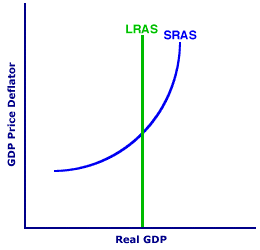
|
|
DISEQUILIBRIUM, SHORT-RUN AGGREGATE MARKET: The state of the short-run aggregate market in which real aggregate expenditures are NOT equal to real production, which result in imbalances that induce changes in the price level, aggregate expenditures, and/or real production. In other words, the opposing forces of aggregate demand (the buyers) and short-run aggregate supply (the sellers) are out of balance. Either the four macroeconomic sector (households, business, government, and foreign) buyers are unable to purchase all of the real production that they seek at the existing price level or business-sector producers are unable to sell all of the real production that they have available at the existing price level.
Visit the GLOSS*arama
|
|


|

|
                           INFLATIONARY GAP: The difference between the equilibrium real production achieved in the short-run aggregate market and full-employment real production that occurs when short-run equilibrium real production is more than full-employment real production. An inflationary gap, also termed an expansionary gap, is associated with a business-cycle expansion, especially the latter stages of an expansion. This is one of two alternative output gaps that can occur when short-run equilibrium generates production that differs from full employment. The other is a recessionary gap. An inflationary gap is a key facet of macroeconomics, especially the analysis of business cycles and the problem of inflation that perpetually puzzles political leaders. Inflation is the prime problem that emerges during the latter stages of a business-cycle expansion which corresponds to an inflationary gap in the aggregate market.| Inflationary Gap |  |
The aggregate market presented in the graph to the right can provide an understanding of an inflationary gap. The vertical long-run aggregate supply curve, labeled LRAS, marks full-employment real production. Long-run equilibrium in the aggregate market necessarily results in full-employment real production.The positively-sloped short-run aggregate supply curve is labeled SRAS. Short-run equilibrium in the aggregate market occurs at the price level and real production corresponding to the intersection of the aggregate demand curve and this SRAS curve. Should short-run real production exceed full-employment real production, then an inflationary gap results. However, to identify an inflationary gap an aggregate demand curve needs to be added to the graph. To include the aggregate demand curve and illustrate an inflationary gap for this aggregate market, click the [Inflationary Gap] button. Doing so reveals a short-run equilibrium level of real production that is greater than full employment, which is an inflationary situation. Note that the aggregate demand curve, labeled AD, intersects the SRAS curve at a real production level to the right of the LRAS curve. This means the short-run real production is greater than full-employment real production. The difference between short-run equilibrium real production and full-employment real production is the inflationary gap. The basic reason for the emergence of an inflationary gap is a short-run imbalance between resource prices, especially wages, and the price level. With real resource prices out of balance, labor and other resources are enticed to exceed their full-employment levels, which prompts subsequent increases in wages and prices, and hence inflation. The primary problem associated with an inflationary gap is, of course, inflation. This tends to reduce the purchasing power of financial assets and can cause the haphazard redistribution of income and wealth. To avoid these problems of inflation, government often considers alternative stabilization policies to correct the situation, including contractionary monetary and fiscal policies. The intent of such policies is to decrease the short-run real production level and move it back to the long-run full-employment level of real production. An inflationary gap also sets in motion the self-correction adjustment mechanism of the aggregate market. Resource market imbalances, in this case shortages that generate overemployment, trigger resource price increases that cause the short-run aggregate supply curve to shift leftward. This shift also decreases short-run real production and moves it toward the full-employment level of real production.

Recommended Citation:INFLATIONARY GAP, AmosWEB Encyclonomic WEB*pedia, http://www.AmosWEB.com, AmosWEB LLC, 2000-2024. [Accessed: May 2, 2024].
Check Out These Related Terms... | | | | | | | | |
Or For A Little Background... | | | | | | | | | | | | |
And For Further Study... | | | | | | | |
Search Again?
Back to the WEB*pedia
|



|

|
|
The first U.S. fire insurance company was established by Benjamin Franklin in 1752 in Philadelphia.
|

|
|
"Leadership is based on inspiration, not domination; on cooperation, not intimidation. " -- William A. Ward
|

|
RTA
Regional Trading Arrangement
|

|
|
Tell us what you think about AmosWEB. Like what you see? Have suggestions for improvements? Let us know. Click the User Feedback link.
User Feedback
|


|


